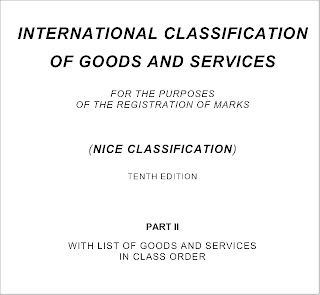Lost among the excitement in European trademark circles this week surrounding the IP TRANSLATOR decision (see IPKat’s posts hereand here), is a subtlety spotted by Niamh Hall, which trademark practitioners might want to think about. Since Niamh knows more about trademark law than this Kat is ever likely to, I leave the explanation to her:
One point which I haven't seen emphasised: both the decision and the OHIM communicationsay that class heading means you cover "all of the goods or services in the alphabetical list of the Nice Agreement for that class", not all goods or services that could fall in that class. So it is still a rather artificial restriction on how you interpret the class heading.
If it's not here, it's not part of the class heading For example, the Alphabetical List only covers an average about 200 items per class. By comparison, Euroclass has 1800 items in class 35 so there are a lot of terms which are not included in the Alphabetical List.Bottom line is, if it's not clearly covered by the class heading terms and it's not in the Alphabetical List, you still need to specify it separately.Given that the Alphabetical List is now our new Rosetta Stone, I thought you might want to publicise the link to the WIPO page where you can find it in handy PDF format: http://www.wipo.int/classifications/nivilo/index_pdf.htm
The IPKat wishes to add two further observations.
1. The OHIM Communication says that existing registrations in respect of the class heading are deemed to cover the alphabetical list of that class “in the edition in force at the time when the filing was made.”
The IPKat does not follow in any detail the ruminations of the Committee of Experts which from time to time issues a new version of the classification, but clearly the list both grows and is pruned back over time. The first edition of the Nice Classification was published in 1963, with subsequent editions appearing in 1971, 1981, 1983, 1987, 1992, 1996, 2001, 2006 and the current (tenth) edition entering into force on January 1, 2012.
A thoroughly unscientific analysis of the relatively short list of services under the letter “V”, for example, shows that between the 7th edition(1997) and 10th edition, services such as vehicle roadworthiness testing and voicemail services have entered the Alphabetical List. So one may need to consult older versions of the Alphabetical List for older registrations, rather than assuming that the current Alphabetical Listing for a given class applies.
2. The IPKat does not know what the implications of the Decision are for those registrations which used only some of the broad terms from a class heading. The presumption that existing registrations cover all goods in the Alphabetical List for a given class only applies if the specification used “all the general indications listed in the class heading of a particular class”.
 |
| Where's my side arm? photo: Dylan Foley |
Take for example a registration in class 8 covering “Hand tools and implements (hand-operated); cutlery; razors”. The full class heading also includes “side arms”, but our hypothetical registrant, a lifelong pacifist, omitted this designation.
The Alphabetical List for class 8 includes “tool belts” and “shaving cases”. While the IPKat lacks opposable thumbs for tool use (and indeed any inclination to manual labour), and he is violently opposed to any cutting of whiskers, he suspects that a tool belt is not itself a tool and a shaving case is not a razor. So because the full class heading was not used, hand tools cannot be assumed to include tool belts (which were clearly only listed in this class because they were so closely associated. Similarly while the registration specifies razors this cannot be assumed to include shaving cases. Had the registrant been lazier, more warlike, or prescient enough to leave “side arms” in the original list when applying, then the registration would now be deemed by OHIM to cover tool belts and shaving cases.
Ah! you may cry, but a registration extends to similar goods and services, and tool belts and shaving cases are probably similar enough to tools and razors, respectively to be covered by the registration. True, but this is not as certain for either the owner or the public. And consider money belts and spectacle cases. If the specification of goods were deemed to actually include tool belts, perhaps a money belt would fall within the scope of the registration for infringement purposes as "similar goods"? However, if one cannot look to the Alphabetical List simply because "side arms" were omitted from the class heading, then the IPKat thinks the comparison must be between money belts and hand tools rather than between money belts and tool belts. Perhaps the same would apply when considering whether a spectacle case is similar to a shaving case for infringement purposes, as opposed to comparing a spectacle case to a razor?
So the issue of whether or not an applicant used the entire class heading, may determine whether or not one can even look at the Alphabetical List in respect of those terms from the class heading which were used.
(Merpel says, what I love about the Nice class headings is that one can savour words that dropped out of common parlance decades ago, like meerschaum, gutta-percha and sago. Sherlock Holmes lookalikes, historians of golf, and survivalists may not agree that these words are so very obscure.)
